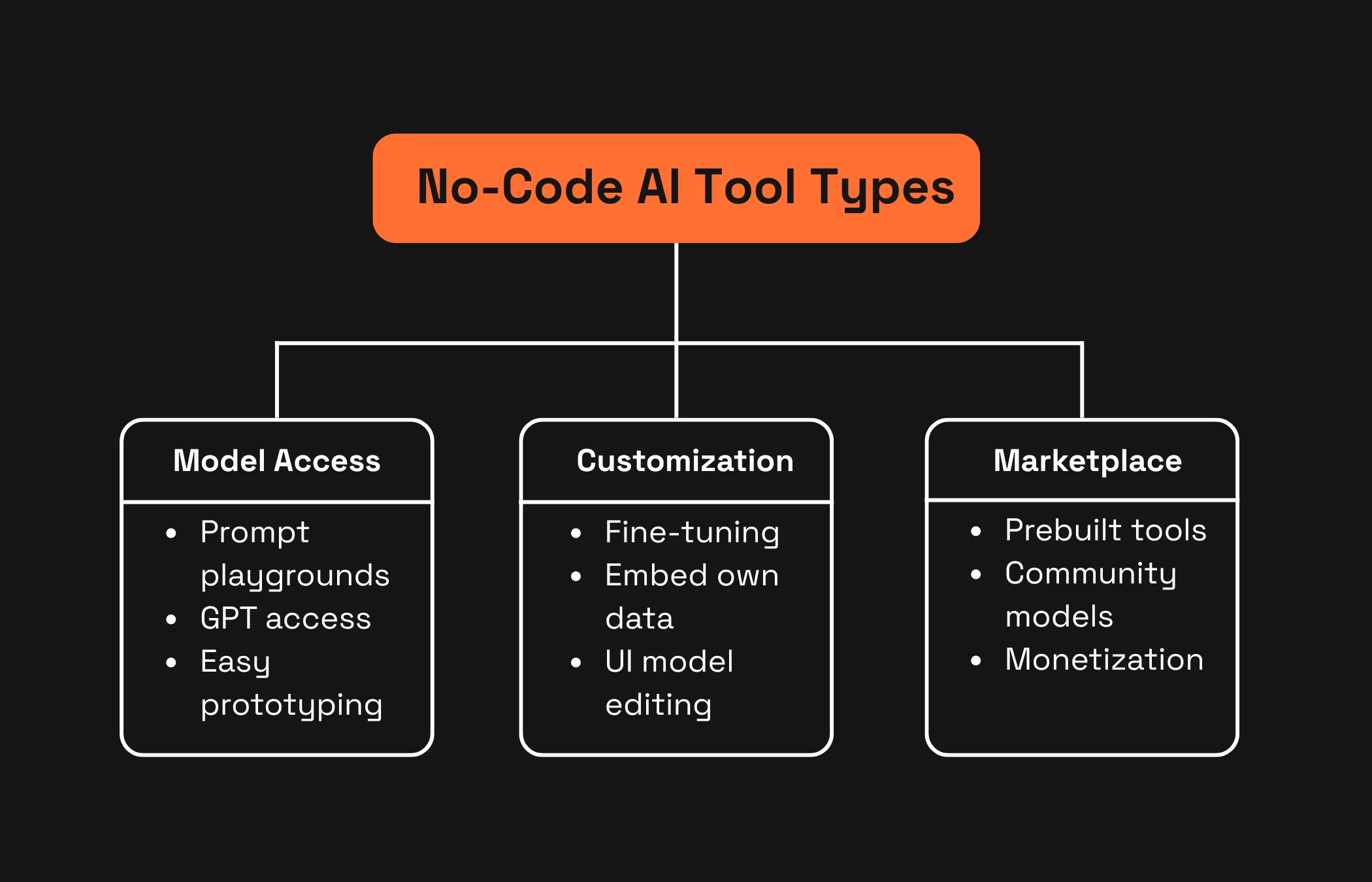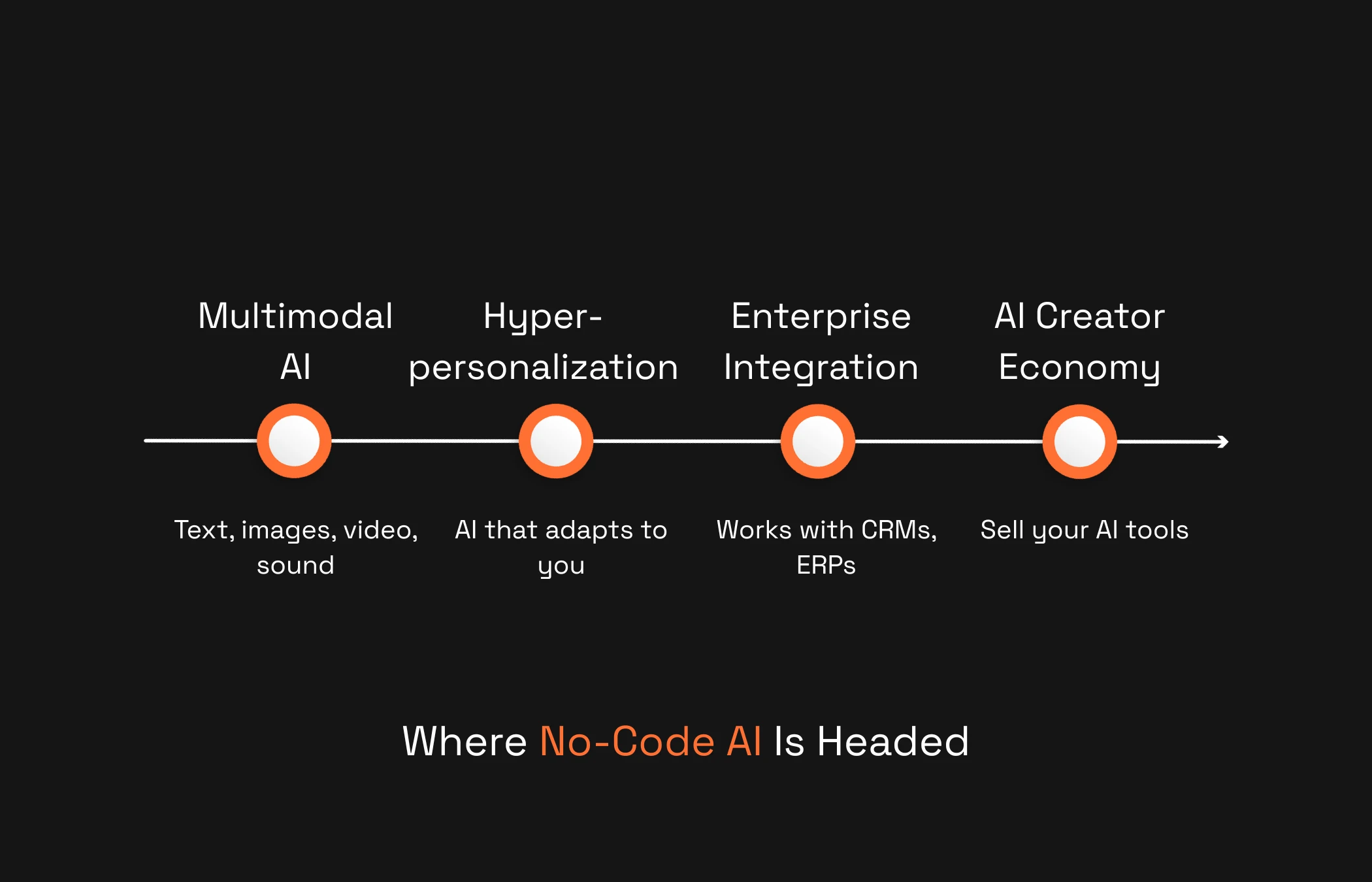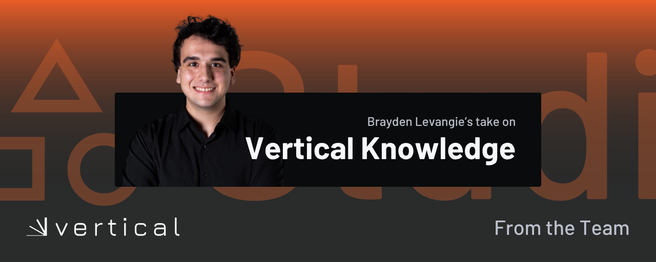The Evolving No-Code Vertical AI Landscape
Published on May 23, 2025 · 10 min read

The Evolving No-Code Vertical AI Landscape
Finetuning AI models is no longer reserved for PhDs and engineers. With the rise of no-code AI platforms, the ability to create, customize, and deploy intelligent systems is now in the hands of professionals across industries. From marketers and analysts, to product managers and more. We're witnessing a fundamental shift: from elite coding expertise to everyday AI enablement.
At the same time, the no-code AI space remains fragmented. Some platforms offer access to pre-trained models. Others let users fine-tune models for niche applications. A few have started building marketplaces. But rarely do these elements come together in a cohesive, creator-friendly experience.
This article maps the evolving no-code AI landscape. We’ll define what vertical AI is, explore how no-code tools are transforming access and innovation, and compare the leading platforms across three core categories: model access, customization, and marketplaces. Finally, we’ll show where Vertical AI stands in this ecosystem—and why it might represent the next stage of intelligent software.
Understanding the vertical AI revolution
Vertical AI refers to models trained or fine-tuned for a specific industry, domain, or use case. Unlike general-purpose AI, which is designed to do a bit of everything, vertical AI focuses on doing one thing with deep contextual expertise.
Instead of asking ChatGPT to "act like a legal expert," vertical AI actually becomes one—trained on legal terminology, contracts, workflows, and regulations. This depth enables more reliable, nuanced, and trustworthy outputs.
As organizations accumulate more data within their own verticals, the need for domain-specialized AI becomes not just beneficial but necessary. The vertical AI revolution is about precision, trust, and outcome-driven intelligence.
From elite coders to no-code AI creators
Until recently, building vertical AI solutions meant writing code, managing infrastructure, and understanding complex frameworks. Most tools were built for developers, not domain experts. Popular platforms that typically require coding include:
Hugging Face – although offering some no-code features, Python is used for training and deploying models
LangChain – for chaining LLM calls with logic, APIs, and memory (Python/JS)
OpenAI API – flexible but requires prompt engineering and backend integration
RunwayML (advanced features) – visual interface with code-based extensions
These platforms are powerful—but they assume technical fluency.
Not all "no-code" platforms are created equal either. Some still involve scripting, backend setup, or API knowledge. A true no-code AI platform allows users to:
Access and interact with models using an intuitive interface
Customize AI behavior through natural language, UI components, or guided workflows
Deploy or share results without writing code or managing infrastructure
Why does this matter? Because it opens the door for users who understand the problem—not just the code—to shape the solution. This leads to:
Lower development costs
Faster iteration cycles
More relevant outputs, since creators are closer to the context
By lowering the barrier to entry, no-code platforms are accelerating innovation inside companies. AI is no longer something you "adopt" externally. It's becoming something you can build and own internally.
Categorizing the AI no-code ecosystem
To better understand where vertical AI platforms like Vertical fit in, it's helpful to break the current landscape into three categories:
Type 1: AI model access platforms
These platforms give users a gateway to interact with foundational models. They usually don’t offer deep customization but are excellent for quick experiments or simple use cases.
Examples:
OpenAI Playground: Mostly no-code for testing purposes. It lets you prompt GPT models directly in-browser
Replicate: Leans more toward developer use for deployment (via APIs). It offers access to open-source models via hosted endpoints
Strengths:
Easy to use
Great for learning and prototyping
Limitations:
Little to no fine-tuning
Not optimized for specific business workflows
Type 2: (Vertical) AI customization tools
These tools let users shape AI behavior more precisely, often through fine-tuning, embedding domain-specific data, or adjusting model responses via UI.
Examples:
Obviously.ai: Is truly no-code. It lets users build predictive models using spreadsheets
Create ML (Apple): Is more "low-code" — accessible, but Apple dev environment knowledge is helpful. It enables model training with user data, mostly for iOS apps
Strengths:
Increased control over AI behavior
Useful for domain-specific applications
Limitations:
Still often require some technical familiarity
Usually disconnected from wider deployment environments
Type 3: AI marketplaces and ecosystems
These platforms host reusable AI models, or tools that others can adopt, often with a credit-based or usage-based pricing model.
Examples:
Vercel AI Marketplace: No-code for users, but building tools on these platforms typically requires code. Experimental apps and tools built on open models
Hugging Face Spaces: No-code for users, but building tools on these platforms typically requires code. It allows hosting of community-created AI apps
Strengths:
Community-driven
Faster time to value through pre-built solutions
Limitations:
Quality varies
Limited interoperability across tools
Platforms like Vertical are rare in that they blend aspects of all three: offering model access, no-code customization, and a built-in marketplace—without requiring technical expertise. This positions them uniquely within the evolving ecosystem.

How leading no-code AI platforms stack up
To help professionals choose the right solution, let’s look at how today’s leading platforms compare across key criteria:
Platform | Model Access | Customization | Marketplace | Ease of Use | Target Audience | Coding Required |
Hugging Face | High | Medium | High | Medium | Developers, researchers | Moderate to High |
Poe | High | Low | Low | High | Casual users | None |
Fal | Medium | Medium | Medium | Medium | Builders, developers | Low to Moderate |
Vertical AI | High | High | High | High | Professionals, teams | None |
Evaluation Criteria:
Model Access: Breadth of models available for interaction (e.g. GPT, Claude, open-source LLMs)
Customization: Ability to tailor, prompt-tune, or fine-tune models for specific use cases
Marketplace: Availability of reusable tools, models, or outputs for others to adopt
Ease of Use: How easily a non-technical user can get value from the platform
Coding Required: The level of technical expertise needed to build or deploy value
Where Vertical AI fits:
Vertical AI combines the strengths of all three categories:
It gives users access to a wide range of top-tier AI models, from ChatGPT to Claude
It allows creators to fine-tune these models, without writing code
It powers a marketplace where the trained models can be used and shared
This integrated approach means users don’t have to juggle multiple tools to build or deploy AI solutions. It also fosters a new kind of ecosystem—one where creators are incentivized, users are empowered, and vertical AI becomes accessible across industries.
Vertical AI isn’t just another platform. It’s a bridge between experimentation and application. Between access and ownership.
Future trends: Where no-code AI is heading
The no-code AI space is evolving rapidly. Four key trends are shaping its future:
Multimodal capabilities: Platforms are expanding beyond text and image to support video, audio, and real-time data.
Hyper-personalization: Models will increasingly adapt to individual users, not just broad industry use cases.
Enterprise integration: AI tools will connect more deeply with internal systems like CRMs, ERPs, and business dashboards.
The rise of the AI creator economy: Sharing and monetizing custom AI models will become as common as building apps.
Platforms like Vertical are well-positioned for this shift. Their flexible infrastructure and marketplace logic allow users to evolve from consumers to contributors, and from testers to innovators.

Getting started: how to choose the right no-code AI platform
Choosing the right platform depends on your goals. Here are a few questions to guide your decision:
Are you looking to prototype quickly or build something domain-specific?
Do you need access to a wide range of models, or deep customization?
Will your AI solution be used internally, or shared with others?
How important is ease of use and time to deployment?
If you want the flexibility to build, the simplicity to launch, and the infrastructure to grow, a unified platform like Vertical AI may offer the best of all worlds.
The no-code AI revolution isn’t just about removing code. It’s about removing friction—so more people can shape how intelligence is applied in their field.




